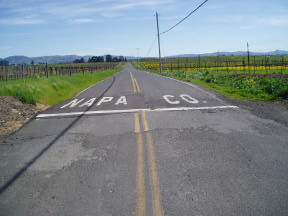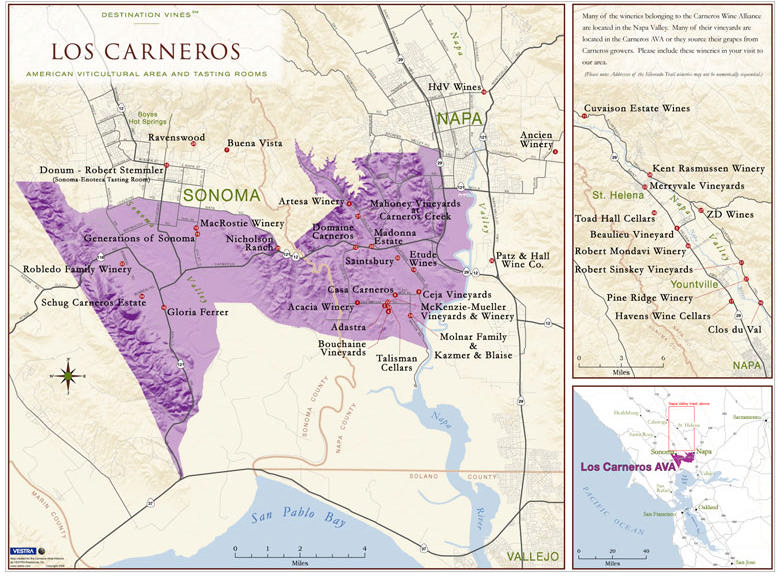Napa Pinot Noir is No Misnomer
For years, Napa has been synonymous with Cabernet Sauvignon (or car parts as the Sonomans like to
say) and Sonoma County has been associated with Pinot Noir. But Napa has also been caught up in the
Pinot Noir craze. How could they ignore the fact that Pinot Noir is the fastest-growing varietal in this
country. According to Impact Databank, Pinot Noir consumption is expected to rise 30% to nearly 3.75
million cases in 2006.
Truth be known, the Napa portion of Carneros and some mountain vineyards in Napa County
(Mayacamas Vineyards, Kuleto and El Molino for example) have been producing Pinot Noir for years.
In addition, many wineries in Napa Valley own vineyards in, or source grapes from, Napa Carneros,
and belong to the Carneros Wine Alliance (see map). A newer development finds some of Napa’s most
visible Cabernet producers spending small fortunes to play the Pinot Noir game. Prominent among
these are Phelps, Pahlmeyer, and Del Dotto along the true Sonoma Coast
The Los Carneros appellation is split about in half with both Sonoma and Napa portions. On Ramal
Road in Carneros, this is noted by a sign drawn on the pavement (photo).
I have compiled a partial list of the wineries in Napa that produce Pinot Noir.
Wineries in Los Carneros
Acacia Wines, Artesa Vineyards & Winery, Adastra, Bouchaine Vineyards, Carneros Creek, Casa
Carneros, Ceja Vineyards, Domaine Carneros, Etude Wines, Kazmer & Blaise, Madonna Estate,
Mahoney Vineyards, McKenzie-Mueller Vineyards & Winery, Molnar Family, Saintsbury, Talisman
Cellars, and Truchard Vineyards.
Other Napa Wineries producing Pinot Noir
Abiouness Wines, Ancien Winery, Anderson’s Conn Valley Vineyards, Andretti Winery, Arger-
Martucci Vineyards, August Briggs, Barnett Vineyards (Santa Lucia Highlands), Beaulieu Vineyard,
Beringer, Cakebread Cellars, Cartlidge & Browne, Caymus Vineyards (Belle Glos), Cliff Lede
Vineyards, Clos Pegase, Cosentino, Cuvaison Estate Wines, Del Dotto Vineyards (Sonoma Coast),
DomaineChandon, Duckhorn Vineyards (Goldeneye), Dutch Henry Winery, Elizabeth Spencer,
Elkhorn Peak, El Molino Winery, Flora Springs, Franciscan Estates, Hagafen Cellars, Joseph Phelps
Vineyards, Judd’s Hill, Kent Rasmussen Winery, Kuleto Estate Family vineyards, Louis Martini,
Markham, Mario Perelli-Minetti Winery, Mayacamas Vineyards, Miner Family Vineyards (Santa Lucia
Highlands), Merryvale, Monticello, Patz & Hall, Phelps (Sonoma Coast), Peter Michael Winery,
Reynolds Family Winery, Robert Mondavi Winery, Robert Sinskey Vineyards, Signorello Vineyards,
Sterling, Sutter Home/Trinchero, Toad Hall Cellars, Twomey, V Sattui Winery, Villa Mt Eden, and ZD
Wines.
Besides the “pinofication” of Napa, there is an ongoing “napafication” of Sonoma. Sonoma used to be
very laid back and rural, some might say unsophisticated, and people in Sonoma relished their lifestyle.
Healdsburg, however, now personifies everything that St Helena does, with high-end restaurants
like the Dry Creek Kitchen and Cyrus, luxury hotels like Hotel Healdsburg and Les Mars, and
chic boutiques that rival any along Highway 29. Tina Caputo, writing in the San Francisco Chronicle
recently, pointed out that visits to Sonoma wineries are increasing and Sonoma is attracting more of the
high-end travelers of the type that always headed for Napa. She quotes vintner Jeff Mayo who predicts
that Napa and Sonoma will someday be thought of as a single wine region. Mayo said, “People used to
only say ‘Napa’ or ‘Sonoma,’ but now I hear people saying ‘Napa-Sonoma.’ The Napa portion of
Carneros remains more Sonoma-like (see photo), while the Sonoma portion of Carneros is becoming
more Napa-like (note the new spectacular Jacuzzi Winery on Hwy 121).






